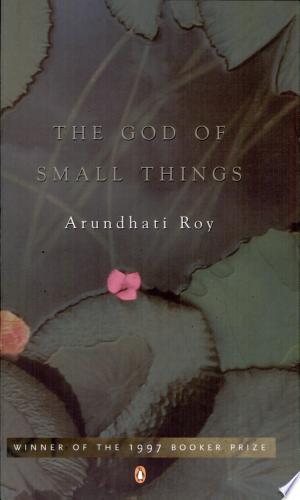Estimated read time: 4 min read
One Sentence Summary
"The God of Small Things" by Arundhati Roy is a poignant tale of forbidden love and societal constraints in 1960s India.
Introduction
"The God of Small Things" is a novel written by Indian author Arundhati Roy. This Booker Prize-winning novel is set in the Indian state of Kerala and revolves around the lives of fraternal twins, Rahel and Estha, and the events that unfold within their family. The story delves into themes of love, social discrimination, family, and the consequences of societal norms. Through vivid storytelling and intricate character development, Roy crafts a narrative that captures the complexities and nuances of human relationships.
Brief Synopsis
Plot Overview and Setting
The novel is set in Ayemenem, a small town in Kerala, India, against the backdrop of political and social upheaval. The narrative encompasses different time periods, shifting between the present day and the twins' childhood in the late 1960s. The story unfolds within the family's ancestral home, where the twins, Rahel and Estha, navigate the complexities of their family dynamics and the societal norms that govern their lives.
Main Events
| Chapters | Summary |
|---|---|
| 1-4 | Introduction of characters and setting the stage for the narrative. The arrival of Sophie Mol, the twins' cousin, and the subsequent events that lead to tragedy. |
| 5-8 | Flashbacks to the twins' childhood, exploring their bond and the challenges they face within their family. The novel delves into the social hierarchy and the impact of societal expectations on the characters. |
| 9-12 | Revelations about the family's past and the events that led to the tragedy. The narrative highlights the consequences of forbidden love and the societal repercussions. |
| 13-16 | The aftermath of the tragedy and its impact on the family. The narrative explores themes of loss, guilt, and the burden of secrets. |
| 17-20 | Conclusion and resolution of the narrative, with a focus on the twins' reunion and the enduring impact of the events on their lives. |
Main Characters
Rahel
Rahel is one of the fraternal twins and is known for her free-spirited nature and artistic inclinations. She grapples with the complexities of her family's dynamics and the impact of societal expectations on her life.
Estha
Estha, Rahel's twin brother, is depicted as a sensitive and introspective character. He bears the weight of traumatic events from his childhood and struggles with finding his place in the world.
Ammu
Ammu is the twins' mother, who experiences the challenges of being a woman in a conservative society. Her forbidden love and subsequent struggles form a significant part of the narrative.
Velutha
Velutha is an untouchable, and his story intertwines with the family's, highlighting the societal prejudices and the consequences of breaking social norms.
Themes and Insights
"The God of Small Things" delves into various themes that offer deep insights into human experiences and societal dynamics. Some of the prominent themes include:
- Love and Forbidden Relationships: The novel explores the complexities of love and the consequences of forbidden relationships in a society bound by rigid social norms.
- Social Hierarchy and Prejudice: Roy vividly portrays the impact of social hierarchy and prejudice on the characters, shedding light on the injustices and discrimination prevalent in the society.
- Family and Relationships: The dynamics within the family, the bonds between the characters, and the impact of tragic events on familial relationships are central to the narrative.
- Political and Social Unrest: The backdrop of political and social unrest in Kerala provides a canvas for the characters' lives, reflecting the larger societal upheavals.
Reader's Takeaway
"The God of Small Things" offers readers a poignant and thought-provoking exploration of human emotions, societal constraints, and the intricate interconnectedness of lives. Through rich storytelling and evocative prose, Arundhati Roy weaves a narrative that leaves a lasting impression on readers, prompting reflection on the complexities of human relationships and the impact of societal norms.
Conclusion
Arundhati Roy's "The God of Small Things" stands as a compelling work of fiction that captures the intricacies of human experiences within the backdrop of a society grappling with change and tradition. The novel's vivid portrayal of characters and their interconnected lives, coupled with its exploration of profound themes, makes it a captivating and resonant read for audiences seeking a deeply immersive literary experience.
The God of Small Things FAQ
What is the genre of The God of Small Things?
The God of Small Things is a novel that falls under the genre of literary fiction.
Who is the author of The God of Small Things?
The God of Small Things is written by Arundhati Roy.
What is the setting of The God of Small Things?
The novel is set in the southern Indian state of Kerala, primarily in the town of Ayemenem.
What is the plot of The God of Small Things?
The novel follows the story of fraternal twins Estha and Rahel, and explores themes of love, loss, and societal norms in India.
Has The God of Small Things won any awards?
Yes, The God of Small Things won the Man Booker Prize for Fiction in 1997.
What are some major themes in The God of Small Things?
Some major themes in the novel include social hierarchy, forbidden love, family dynamics, and the impact of societal norms.
Is The God of Small Things suitable for young readers?
The novel contains mature themes and language, so it may not be suitable for very young readers.
Is The God of Small Things based on true events?
The novel is a work of fiction, but it is influenced by historical and societal events in Kerala, India.





